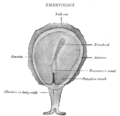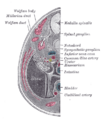Notochord
| Notochord | ||
|---|---|---|
| Transverse section of a chick embryo of forty-five hours’ incubation. | ||
| Gray's | subject #8 52 | |
| Precursor | chordamesoderm | |
| Gives rise to | nucleus pulposus | |
| MeSH | Notochord | |
Notochord is a flexible, rod-shaped supporting structure that is one of the distinguishing features of the phylum Chordatas, being found at some point in the life cycle of all chordates (vertebrates, tunicates, lancelets). Composed of cells derived from the mesoderm, the notochord defines the primitive axis of the embryo and is retained as the main support in the lowest chordates. Lancelets (subphylum Cephalochordata retain the notochord throughout their lives, while tunicates and vertebrates have the notochord only during early (embryonic, larval) stages. Tunicates (subphylum Urochordata) have a notochord as larvae
In lower vertebrates, it persists throughout life as the main axial support of the body, while in higher vertebrates it is replaced by the vertebral column.
in the embryos of all chordates
It is In lower vertebrates, it persists throughout life as the main axial support of the body, while in higher vertebrates it is replaced by the vertebral column. The notochord is found on the ventral surface of the neural tube.
Notochords were the first "backbones", as well, serving as support structures in chordates that lacked a bony skeleton. The very first vertebrates, such as Haikouicthys, had only a notochord. Embryos of vertebrates have notochords today, as embryonic development often happens to follow a pattern similar to the ancestral evolution of the modern animal's traits. Notochords were advantageous to primitive fish-ancestors because they were a rigid structure for muscle attachment, yet flexible enough to allow more movement than, for example, the exoskeleton of the dominant animals of that time. In humans, they eventually develop into the nucleus pulposus of the intervertebral discs.
In the adult human, a notochord remnant is the nucleus pulposus of the vertebral disks.
Development of the notochord
Notogenesis is the development of the notochord by the epiblasts that make up the floor of the amnion cavity (Human Embryology). The notochord arises as a pouch from the mesoderm.
The notochord in neural development
Research into the notochord has played a key role in understanding the development of the central nervous system. By transplanting and expressing a second notochord near the dorsal neural tube, 180 degrees opposite of the normal notochord location, one can induce the formation of motoneurons in the dorsal tube. Motoneuron formation generally occurs in the ventral neural tube, while the dorsal tube generally forms sensory cells.
The notochord secretes a protein called sonic hedgehog homolog (SHH), a key morphogen regulating organogenesis and having a critical role in signaling the development of motoneurons[1]. The secretion of SHH by the notochord establishes the ventral pole of the dorsal-ventral axis in the developing embryo.
Additional images
Neural development/Neurulation - Neurula - Neural folds - Neural groove - Neural tube - Neural crest - Neuromere (Rhombomere) - Notochord - Neural plate
Eye development - Optic vesicles - Optic stalk - Optic cup - Auditory vesicle - Auditory pit
ReferencesISBN links support NWE through referral fees
- ↑ Echelard Y, Epstein DJ, St-Jacques B, Shen L, Mohler J, McMahon JA, McMahon AP. Sonic hedgehog, a member of a family of putative signaling molecules, is implicated in the regulation of CNS polarity. Cell 1993;75(7):1417-30. PMID 7916661
Credits
New World Encyclopedia writers and editors rewrote and completed the Wikipedia article in accordance with New World Encyclopedia standards. This article abides by terms of the Creative Commons CC-by-sa 3.0 License (CC-by-sa), which may be used and disseminated with proper attribution. Credit is due under the terms of this license that can reference both the New World Encyclopedia contributors and the selfless volunteer contributors of the Wikimedia Foundation. To cite this article click here for a list of acceptable citing formats.The history of earlier contributions by wikipedians is accessible to researchers here:
The history of this article since it was imported to New World Encyclopedia:
Note: Some restrictions may apply to use of individual images which are separately licensed.




